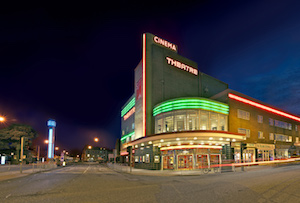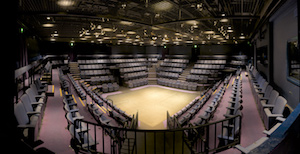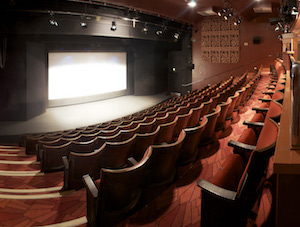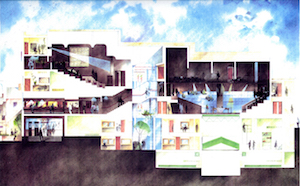The Stephen Joseph Theatre (1996 - present)
This page features an introduction to and history of the Stephen Joseph Theatre (1996 - present). For details of the history of the Odeon cinema, the building which was converted to make the present building, click here.Note: This article (as well as all material on the website relating to the Stephen Joseph Theatre) only covers the period 1996 to 31 March 2009, when Alan Ayckbourn stepped down as Artistic Director of the company.

The exterior of the Stephen Joseph Theatre, Scarborough.
© James Drawneek

The Round auditorium in the Stephen Joseph Theatre.
© James Drawneek

The McCarthy auditorium in the Stephen Joseph Theatre.
© James Drawneek

A cut-away plan for the initial design of the Stephen Joseph Theatre.
© Osborne Christmas Associates
Alan Ayckbourn, Artistic Director of the company, suggested the idea of converting the former cinema into a state-of-the-art home for theatre in the round in Scarborough in 1989; the only other serious suggestion for the building being to turn it into a bingo hall. His enquiries into the possibility of acquiring the empty Grade II listed building led to the discovery the Rank company wanted £300,000 for the remaining 48 years of the lease. However, confident he had found the perfect home for the company and after much negotiation, Alan formed the ADMirable partnership in 1990 with Lord Downe and Charles ‘Mac’ McCarthy. They each put £50,000 of their own money together with a bank loan for £100,000 and managed to secure the lease of the building for £250,000; Scarborough Borough Council subsequently increased the lease to 99 years. With the lease for the building secured, work began on raising the funds needed for the extensive conversion of the building.
The initial aim was to open the theatre in 1994 although serious fund-raising did not begin until 1993 with the launch of a major financial appeal which included sponsoring the name of the venue for £800,000; although it was never really in doubt the eventual sponsor would name it after its founder. The Grade II listing of the building meant a complex series of negotiations with English Heritage, which eventually led to the agreement that the exterior of the building and the Front Of House areas would be restored and reflect the building's Art Deco origins when it opened in 1936. The rest of the building - particularly the Round auditorium - would be redeveloped from the ground up in order to create a state-of-the-art venue and facilities.
The conversion and move to the new building eventually cost £5.2m and involved refitting the top of the cinema’s circle to create the 165 seat McCarthy Theatre and cinema; the ground floor of the cinema was gutted and the supporting proscenium arch removed to create the space for the 404-seat Round auditorium with a stage-lift and trampoline mesh beneath the lighting rig (apparently the first of its kind in the UK and a clever solution to offering easy and quick access to lighting grids above in-the-round venues).
A hole was also punched through the roof, sinking from it a glass shaft - the ‘atrium’ - to allow natural light to reach the offices in the centre of the building. The building also incorporated a shop, conference room, workshop, full backstage and front of house facilities and a bar and restaurant retaining as far as possible the listed building’s 1930’s features. Even the carpet was a replica of the original carpet taken from a piece that had been found in the old cinema before the conversion.
This marked the first time that all the facilities for the theatre were under one roof. A literary department to evaluate new and submitted work, two rehearsal rooms for simultaneous rehearsal for both auditoria, green room and quiet room, a completely outfitted workshop where all aspects of the sets could be constructed, a stage lift capable of holding three sets at any one point for repertory plays and two auditoria capable of running shows simultaneously; one with cinema facilities. For front of house, a reception, two point-of-service box office, a full-time restaurant, bar, wine bar and shop, storage as well as full administrative offices and outreach / education facilities. The aim being tom operate a seven day-a-week venue with activities and performances running throughout the day. Sadly, reality meant that over the decades, the ultimate aims of the company were never met and the theatre's ambitions were scaled down substantially - particularly following the departure of Alan Ayckbourn in 2009.
Alan's friend, Harry Osborne of Henry Osborne Christmas Associates of Tunbridge Wells, was the concept architect and he worked closely with Alan and the company to create a design that incorporated both a state-of-the-art theatre whilst paying homage to the building's 1930s origins. Shepherd Design and Build of York were responsible for the actual conversion which was finally completed just in time for the first performance on 24th of April 1996; the theatre's official opening night took place on 30 April.
To launch the theatre, Alan Ayckbourn turned - unexpectedly - to one of his biggest flops, the 1975 musical Jeeves which he had written with Andrew Lloyd Webber. Reuniting with the composer, the pair completely revised the musical and opened the Stephen Joseph Theatre with By Jeeves; which despite the doubters and naysayers proved to be an enormous success, later transferring to London before touring the UK and - several years later - opening on Broadway.
Alan Ayckbourn was keen that the entire venue was used to its maximum potential and that the smaller end-stage McCarthy Theatre would not be seen as a second or studio theatre, but as an equally important performing space as The Round. Unfortunately, these ambitious aims for the building stumbled almost immediately. Within six months of opening there was a funding crisis due to the three-way funding deal between Scarborough Council, North Yorkshire County Council and the Arts Council - just one pulling out could jeopardise the entire subsidy agreement with first Scarborough Town Council and then North Yorkshire County Council threatening to cut its funding. Alan Ayckbourn found himself fighting to secure the future of the Stephen Joseph Theatre in a story which received national media coverage, even going so far as to state the theatre would close its doors in September 1997 if the subsidies was not restored. The funding was eventually secured but Alan Ayckbourn later revealed the venue was being run on essentially the same sized subsidy as for the company's previous home, which was less than half the size of the new building. Sadly, the insecurity of funding would constantly dog the venue over the coming years and it was never able to run year-round to its maximum potential as Alan Ayckbourn had hoped and envisaged.
Despite this, the theatre continued to place Stephen Joseph and his legacy of embracing new writing as the keystone of the theatre's vision throughout Alan Ayckbourn's tenure as Artistic Director. The lunchtime plays - so popular at Westwood - continued in The Restaurant and occasionally expanded into The McCarthy. The visiting programme was massively increased with popular companies such as the Northern Broadsides and Hull Truck Theatre becoming regular visitors alongside popular concert events such as the Hammonds Saltaire Band and Music In The Round concert series. Certainly during it first decade, every effort was to make the venue as vibrant and as a busy a venue as possible within the restrictions of funding and budget.
In 2005, the contribution of Stephen Joseph to Scarborough saw a blue plaque attached outside Scarborough Library to mark the 50th anniversary of Stephen Joseph opening Theatre in the Round at the Library Theatre. An important milestone had been reached for the company in the town - with another unexpected one soon to follow.
In February 2006, Alan Ayckbourn suffered a stroke and was away from the theatre for six months. Although he returned to work in September 2006 to direct the world premiere of his new play If I Were You, it marked a period of transition for the theatre. The playwright and Artistic Director had previously announced a lightening of his workload in 1999, but in May 2007 he confirmed he would retire as Artistic Director in 2009.
The playwright has since remained connected to the theatre, although only as a guest director and he continues to premiere new work at the venue as well as at other venues. Interestingly, Alan has previously said he considered one of his greatest achievements to have been the move of the Scarborough company into its first purpose built home, the Stephen Joseph Theatre, in 1996. Subsequently though, he has often expressed regret at the scale of the move and that perhaps ultimately more was lost than gained with the move and that the company's best years were at its second home, the Stephen Joseph Theatre in the Round.
Article by Simon Murgatroyd. Copyright: Haydonning Ltd. Please do not reproduce without permission of the copyright holder.